Bega Cheese Limited: Financial Performance Analysis and Ratio Analysis
VerifiedAdded on 2021/06/14
|16
|3234
|125
Report
AI Summary
This report presents a financial analysis of Bega Cheese Limited, evaluating its performance through various financial ratios. The analysis covers liquidity, profitability, efficiency, solvency, and market ratios, comparing Bega Cheese to its competitors. The report examines the company's financial leverage, profitability trends, and market standing, offering insights into its ability to manage short-term and long-term debts, generate profits from sales, and maintain a sustainable future. The analysis includes a detailed interpretation of financial statements and market data, concluding with recommendations for investors based on the company's financial health and market position. The report highlights the importance of long-term investment in Bega Cheese to create value and addresses the challenges posed by high financial leverage.
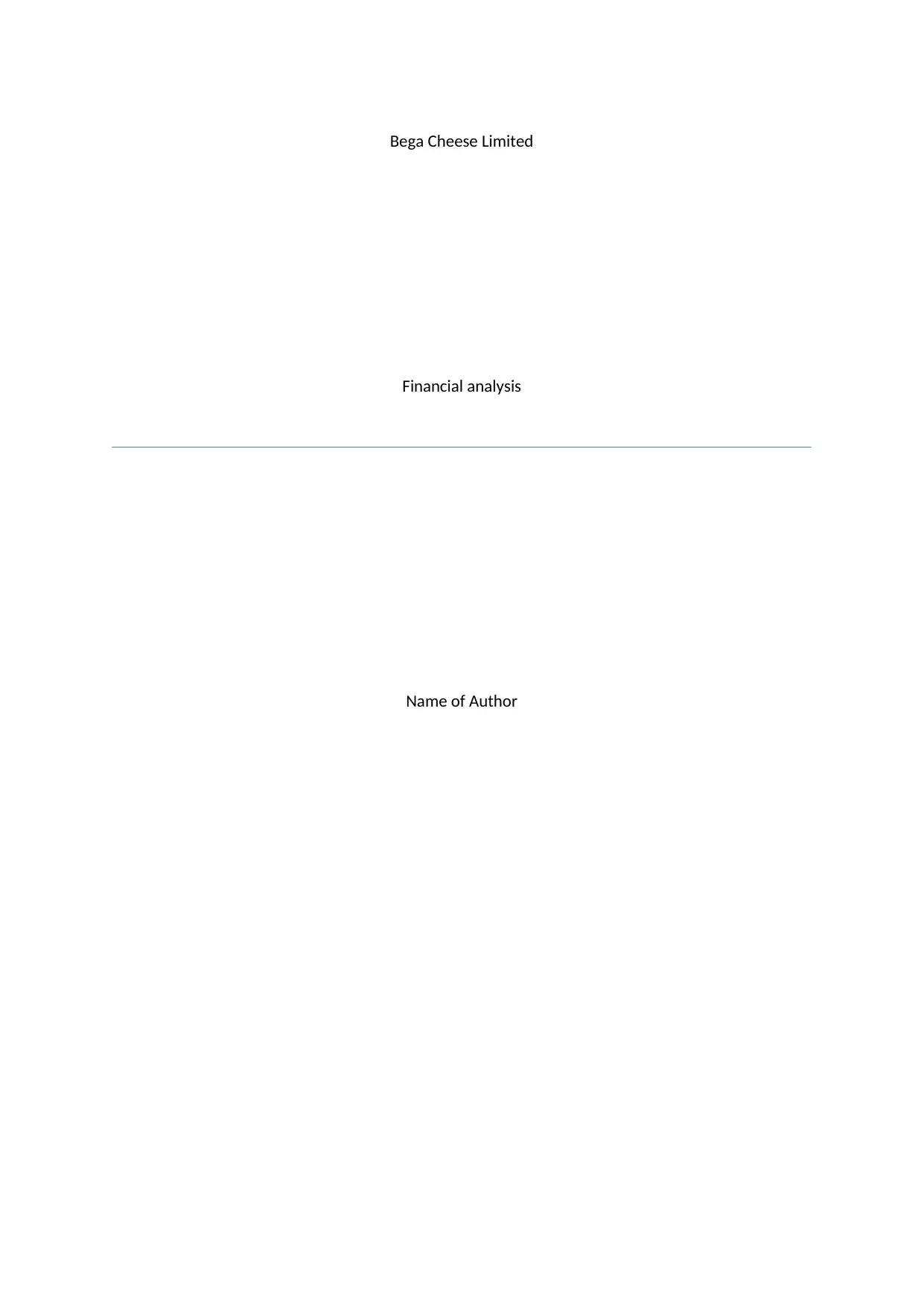
Bega Cheese Limited
Financial analysis
Name of Author
Financial analysis
Name of Author
Paraphrase This Document
Need a fresh take? Get an instant paraphrase of this document with our AI Paraphraser
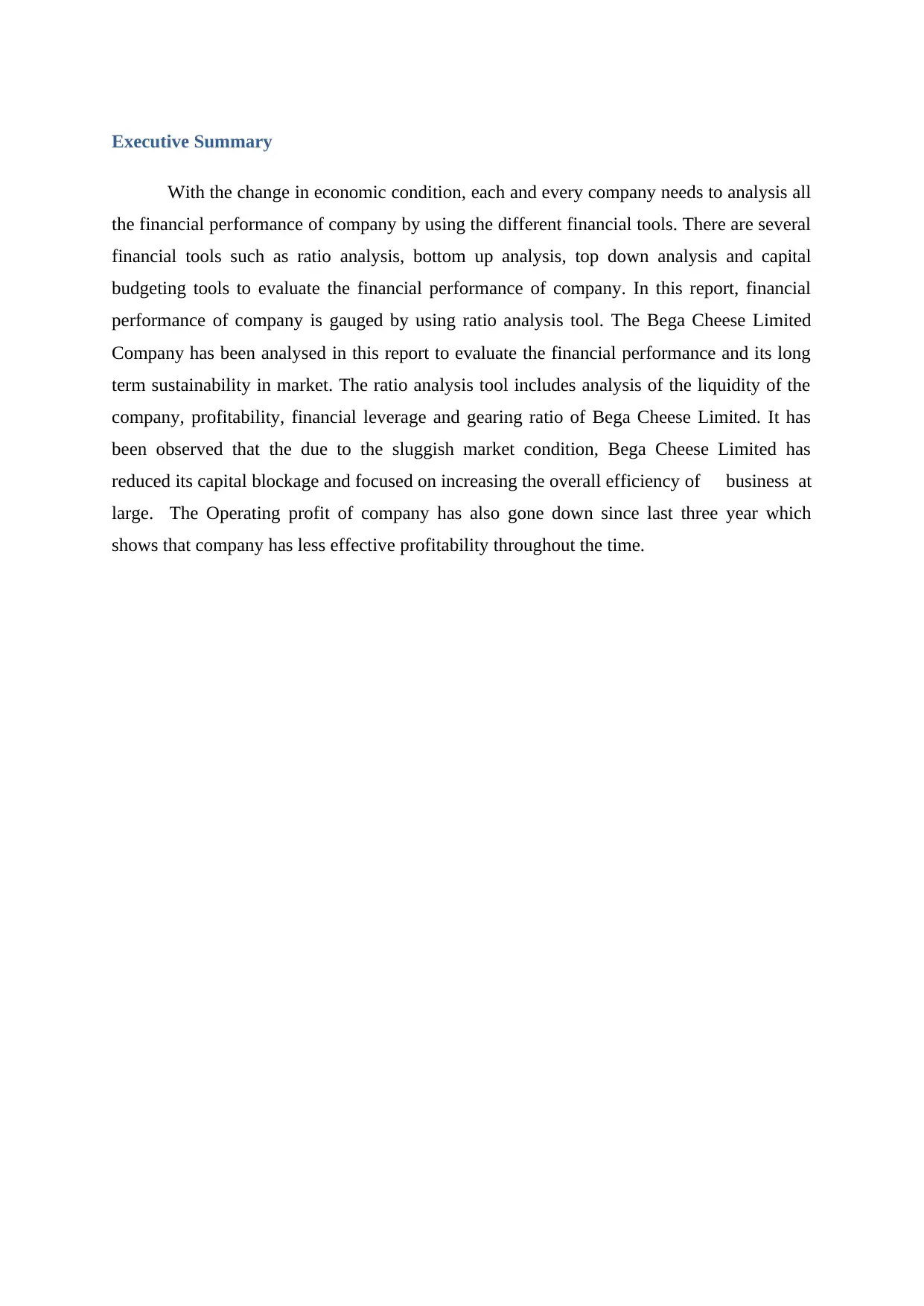
Executive Summary
With the change in economic condition, each and every company needs to analysis all
the financial performance of company by using the different financial tools. There are several
financial tools such as ratio analysis, bottom up analysis, top down analysis and capital
budgeting tools to evaluate the financial performance of company. In this report, financial
performance of company is gauged by using ratio analysis tool. The Bega Cheese Limited
Company has been analysed in this report to evaluate the financial performance and its long
term sustainability in market. The ratio analysis tool includes analysis of the liquidity of the
company, profitability, financial leverage and gearing ratio of Bega Cheese Limited. It has
been observed that the due to the sluggish market condition, Bega Cheese Limited has
reduced its capital blockage and focused on increasing the overall efficiency of business at
large. The Operating profit of company has also gone down since last three year which
shows that company has less effective profitability throughout the time.
With the change in economic condition, each and every company needs to analysis all
the financial performance of company by using the different financial tools. There are several
financial tools such as ratio analysis, bottom up analysis, top down analysis and capital
budgeting tools to evaluate the financial performance of company. In this report, financial
performance of company is gauged by using ratio analysis tool. The Bega Cheese Limited
Company has been analysed in this report to evaluate the financial performance and its long
term sustainability in market. The ratio analysis tool includes analysis of the liquidity of the
company, profitability, financial leverage and gearing ratio of Bega Cheese Limited. It has
been observed that the due to the sluggish market condition, Bega Cheese Limited has
reduced its capital blockage and focused on increasing the overall efficiency of business at
large. The Operating profit of company has also gone down since last three year which
shows that company has less effective profitability throughout the time.
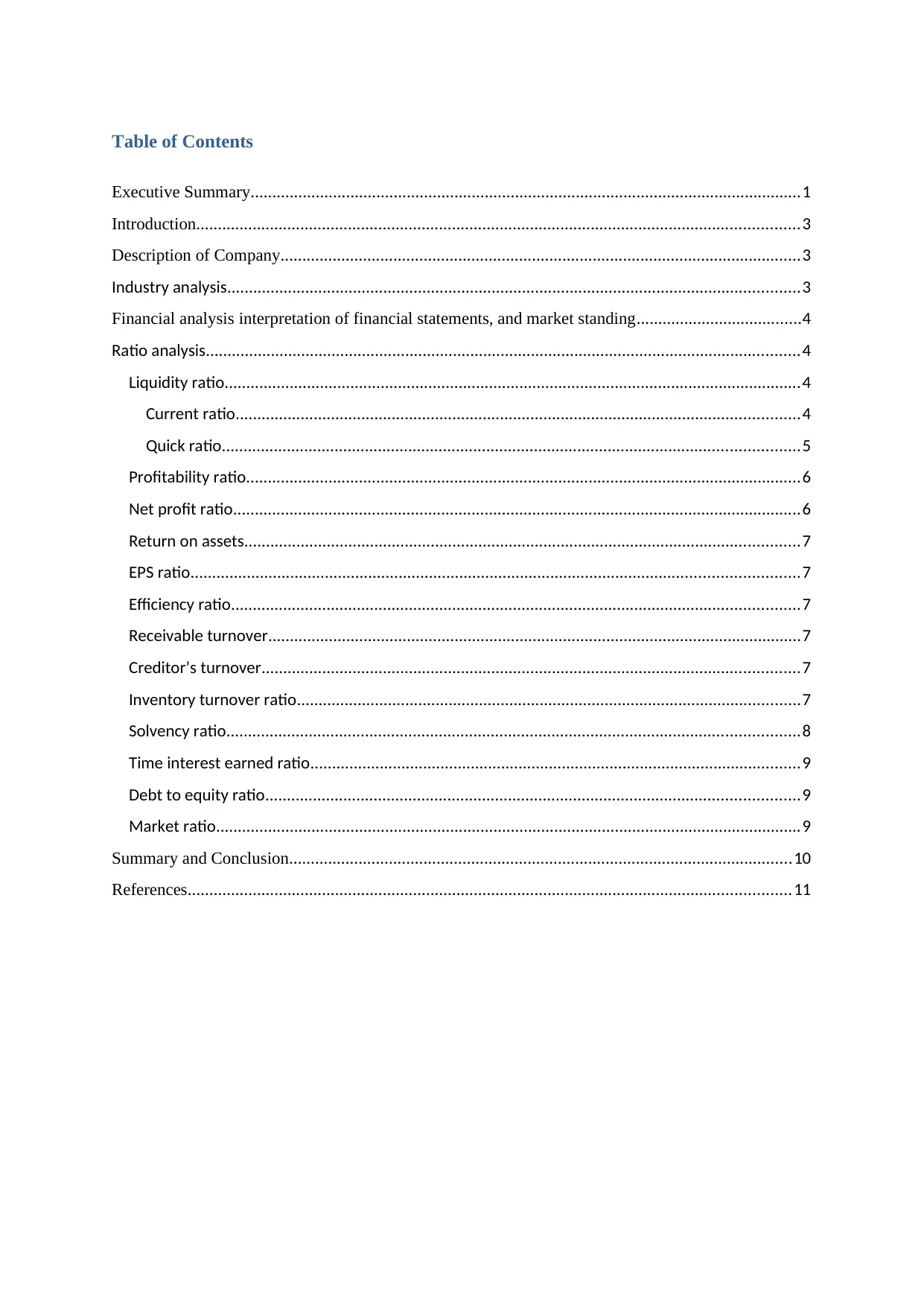
Table of Contents
Executive Summary...............................................................................................................................1
Introduction...........................................................................................................................................3
Description of Company........................................................................................................................3
Industry analysis....................................................................................................................................3
Financial analysis interpretation of financial statements, and market standing......................................4
Ratio analysis.........................................................................................................................................4
Liquidity ratio.....................................................................................................................................4
Current ratio..................................................................................................................................4
Quick ratio.....................................................................................................................................5
Profitability ratio................................................................................................................................6
Net profit ratio...................................................................................................................................6
Return on assets................................................................................................................................7
EPS ratio............................................................................................................................................7
Efficiency ratio...................................................................................................................................7
Receivable turnover...........................................................................................................................7
Creditor’s turnover............................................................................................................................7
Inventory turnover ratio....................................................................................................................7
Solvency ratio....................................................................................................................................8
Time interest earned ratio.................................................................................................................9
Debt to equity ratio...........................................................................................................................9
Market ratio.......................................................................................................................................9
Summary and Conclusion....................................................................................................................10
References...........................................................................................................................................11
Executive Summary...............................................................................................................................1
Introduction...........................................................................................................................................3
Description of Company........................................................................................................................3
Industry analysis....................................................................................................................................3
Financial analysis interpretation of financial statements, and market standing......................................4
Ratio analysis.........................................................................................................................................4
Liquidity ratio.....................................................................................................................................4
Current ratio..................................................................................................................................4
Quick ratio.....................................................................................................................................5
Profitability ratio................................................................................................................................6
Net profit ratio...................................................................................................................................6
Return on assets................................................................................................................................7
EPS ratio............................................................................................................................................7
Efficiency ratio...................................................................................................................................7
Receivable turnover...........................................................................................................................7
Creditor’s turnover............................................................................................................................7
Inventory turnover ratio....................................................................................................................7
Solvency ratio....................................................................................................................................8
Time interest earned ratio.................................................................................................................9
Debt to equity ratio...........................................................................................................................9
Market ratio.......................................................................................................................................9
Summary and Conclusion....................................................................................................................10
References...........................................................................................................................................11
⊘ This is a preview!⊘
Do you want full access?
Subscribe today to unlock all pages.

Trusted by 1+ million students worldwide
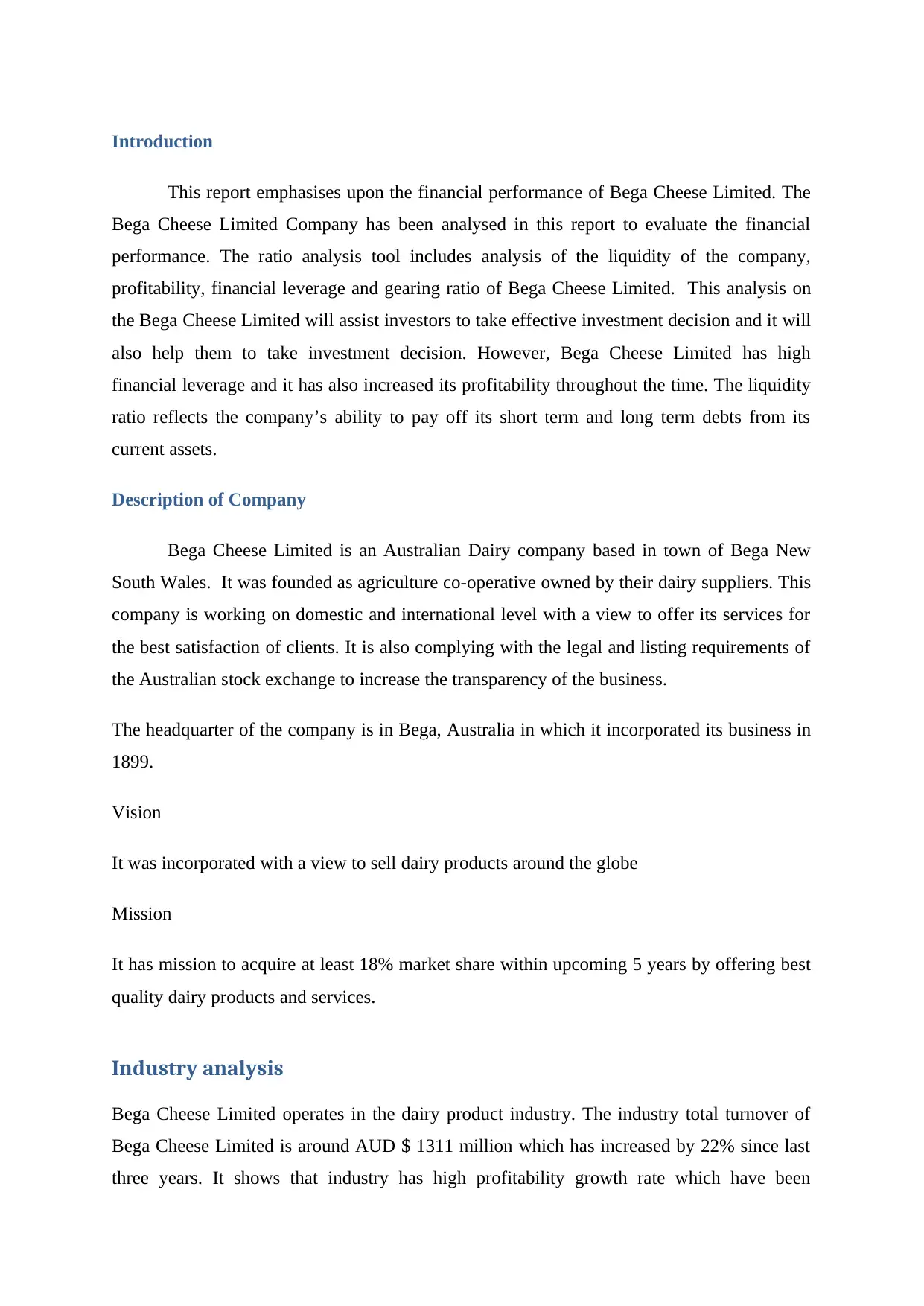
Introduction
This report emphasises upon the financial performance of Bega Cheese Limited. The
Bega Cheese Limited Company has been analysed in this report to evaluate the financial
performance. The ratio analysis tool includes analysis of the liquidity of the company,
profitability, financial leverage and gearing ratio of Bega Cheese Limited. This analysis on
the Bega Cheese Limited will assist investors to take effective investment decision and it will
also help them to take investment decision. However, Bega Cheese Limited has high
financial leverage and it has also increased its profitability throughout the time. The liquidity
ratio reflects the company’s ability to pay off its short term and long term debts from its
current assets.
Description of Company
Bega Cheese Limited is an Australian Dairy company based in town of Bega New
South Wales. It was founded as agriculture co-operative owned by their dairy suppliers. This
company is working on domestic and international level with a view to offer its services for
the best satisfaction of clients. It is also complying with the legal and listing requirements of
the Australian stock exchange to increase the transparency of the business.
The headquarter of the company is in Bega, Australia in which it incorporated its business in
1899.
Vision
It was incorporated with a view to sell dairy products around the globe
Mission
It has mission to acquire at least 18% market share within upcoming 5 years by offering best
quality dairy products and services.
Industry analysis
Bega Cheese Limited operates in the dairy product industry. The industry total turnover of
Bega Cheese Limited is around AUD $ 1311 million which has increased by 22% since last
three years. It shows that industry has high profitability growth rate which have been
This report emphasises upon the financial performance of Bega Cheese Limited. The
Bega Cheese Limited Company has been analysed in this report to evaluate the financial
performance. The ratio analysis tool includes analysis of the liquidity of the company,
profitability, financial leverage and gearing ratio of Bega Cheese Limited. This analysis on
the Bega Cheese Limited will assist investors to take effective investment decision and it will
also help them to take investment decision. However, Bega Cheese Limited has high
financial leverage and it has also increased its profitability throughout the time. The liquidity
ratio reflects the company’s ability to pay off its short term and long term debts from its
current assets.
Description of Company
Bega Cheese Limited is an Australian Dairy company based in town of Bega New
South Wales. It was founded as agriculture co-operative owned by their dairy suppliers. This
company is working on domestic and international level with a view to offer its services for
the best satisfaction of clients. It is also complying with the legal and listing requirements of
the Australian stock exchange to increase the transparency of the business.
The headquarter of the company is in Bega, Australia in which it incorporated its business in
1899.
Vision
It was incorporated with a view to sell dairy products around the globe
Mission
It has mission to acquire at least 18% market share within upcoming 5 years by offering best
quality dairy products and services.
Industry analysis
Bega Cheese Limited operates in the dairy product industry. The industry total turnover of
Bega Cheese Limited is around AUD $ 1311 million which has increased by 22% since last
three years. It shows that industry has high profitability growth rate which have been
Paraphrase This Document
Need a fresh take? Get an instant paraphrase of this document with our AI Paraphraser
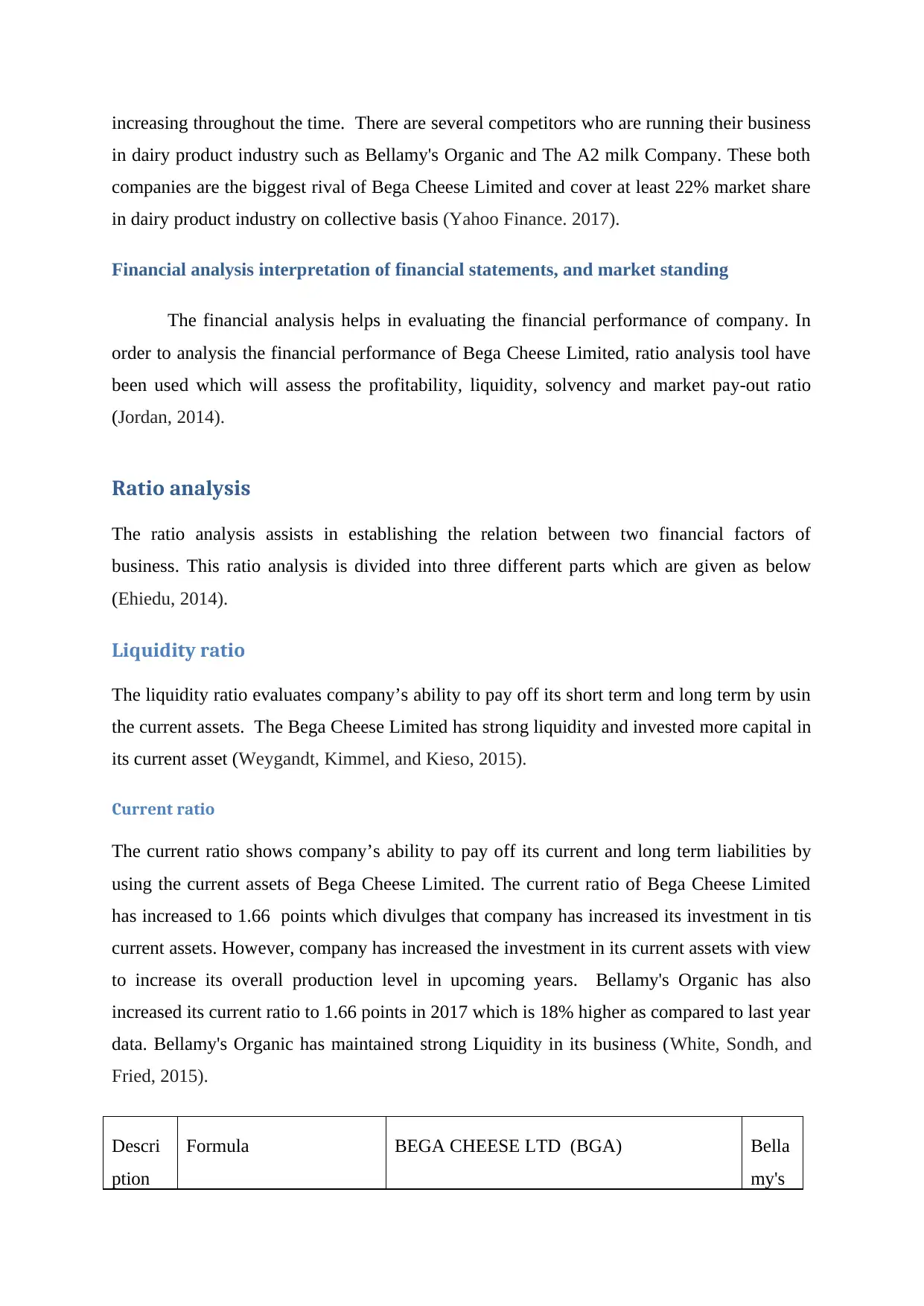
increasing throughout the time. There are several competitors who are running their business
in dairy product industry such as Bellamy's Organic and The A2 milk Company. These both
companies are the biggest rival of Bega Cheese Limited and cover at least 22% market share
in dairy product industry on collective basis (Yahoo Finance. 2017).
Financial analysis interpretation of financial statements, and market standing
The financial analysis helps in evaluating the financial performance of company. In
order to analysis the financial performance of Bega Cheese Limited, ratio analysis tool have
been used which will assess the profitability, liquidity, solvency and market pay-out ratio
(Jordan, 2014).
Ratio analysis
The ratio analysis assists in establishing the relation between two financial factors of
business. This ratio analysis is divided into three different parts which are given as below
(Ehiedu, 2014).
Liquidity ratio
The liquidity ratio evaluates company’s ability to pay off its short term and long term by usin
the current assets. The Bega Cheese Limited has strong liquidity and invested more capital in
its current asset (Weygandt, Kimmel, and Kieso, 2015).
Current ratio
The current ratio shows company’s ability to pay off its current and long term liabilities by
using the current assets of Bega Cheese Limited. The current ratio of Bega Cheese Limited
has increased to 1.66 points which divulges that company has increased its investment in tis
current assets. However, company has increased the investment in its current assets with view
to increase its overall production level in upcoming years. Bellamy's Organic has also
increased its current ratio to 1.66 points in 2017 which is 18% higher as compared to last year
data. Bellamy's Organic has maintained strong Liquidity in its business (White, Sondh, and
Fried, 2015).
Descri
ption
Formula BEGA CHEESE LTD (BGA) Bella
my's
in dairy product industry such as Bellamy's Organic and The A2 milk Company. These both
companies are the biggest rival of Bega Cheese Limited and cover at least 22% market share
in dairy product industry on collective basis (Yahoo Finance. 2017).
Financial analysis interpretation of financial statements, and market standing
The financial analysis helps in evaluating the financial performance of company. In
order to analysis the financial performance of Bega Cheese Limited, ratio analysis tool have
been used which will assess the profitability, liquidity, solvency and market pay-out ratio
(Jordan, 2014).
Ratio analysis
The ratio analysis assists in establishing the relation between two financial factors of
business. This ratio analysis is divided into three different parts which are given as below
(Ehiedu, 2014).
Liquidity ratio
The liquidity ratio evaluates company’s ability to pay off its short term and long term by usin
the current assets. The Bega Cheese Limited has strong liquidity and invested more capital in
its current asset (Weygandt, Kimmel, and Kieso, 2015).
Current ratio
The current ratio shows company’s ability to pay off its current and long term liabilities by
using the current assets of Bega Cheese Limited. The current ratio of Bega Cheese Limited
has increased to 1.66 points which divulges that company has increased its investment in tis
current assets. However, company has increased the investment in its current assets with view
to increase its overall production level in upcoming years. Bellamy's Organic has also
increased its current ratio to 1.66 points in 2017 which is 18% higher as compared to last year
data. Bellamy's Organic has maintained strong Liquidity in its business (White, Sondh, and
Fried, 2015).
Descri
ption
Formula BEGA CHEESE LTD (BGA) Bella
my's
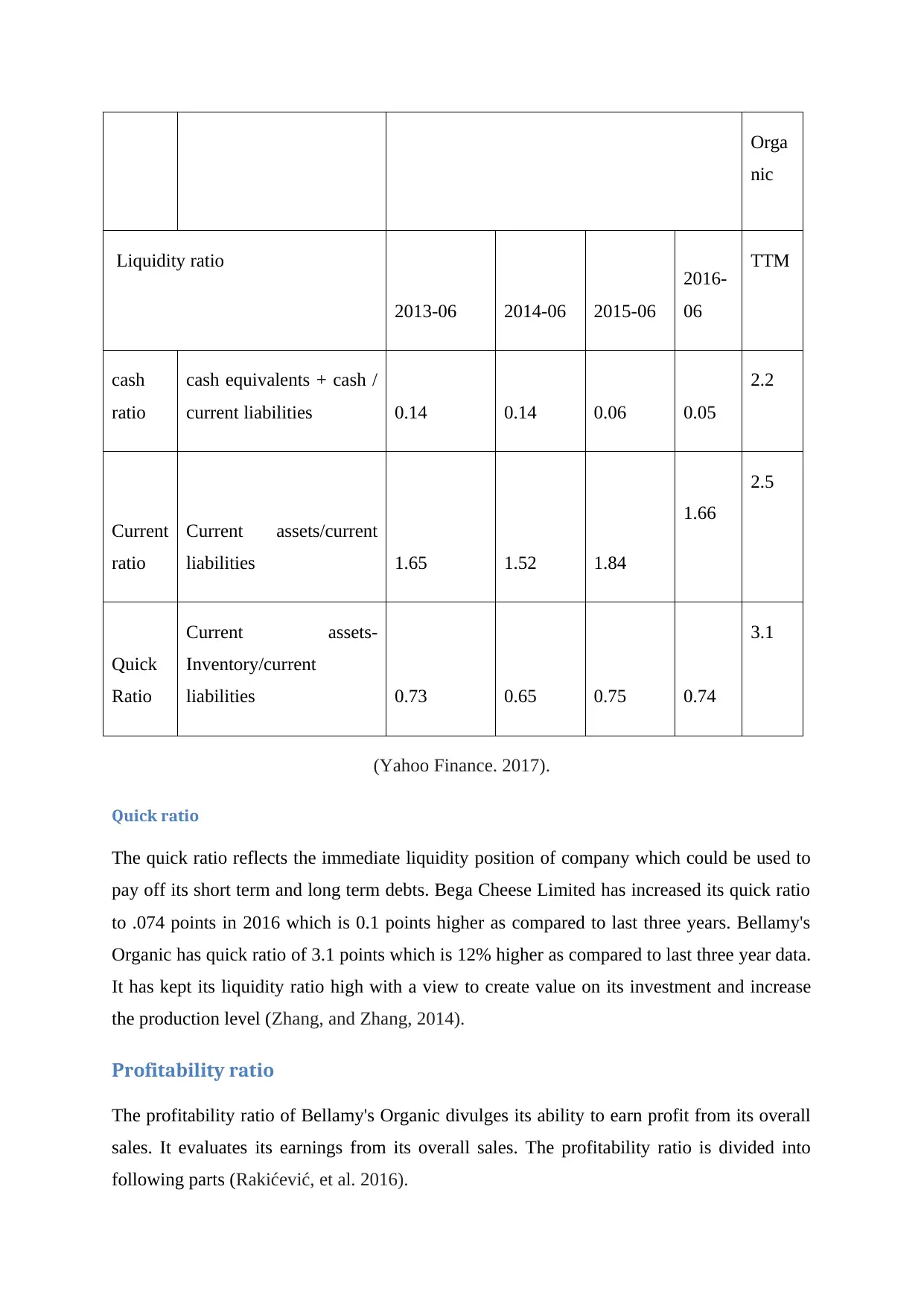
Orga
nic
Liquidity ratio
2013-06 2014-06 2015-06
2016-
06
TTM
cash
ratio
cash equivalents + cash /
current liabilities 0.14 0.14 0.06 0.05
2.2
Current
ratio
Current assets/current
liabilities 1.65 1.52 1.84
1.66
2.5
Quick
Ratio
Current assets-
Inventory/current
liabilities 0.73 0.65 0.75 0.74
3.1
(Yahoo Finance. 2017).
Quick ratio
The quick ratio reflects the immediate liquidity position of company which could be used to
pay off its short term and long term debts. Bega Cheese Limited has increased its quick ratio
to .074 points in 2016 which is 0.1 points higher as compared to last three years. Bellamy's
Organic has quick ratio of 3.1 points which is 12% higher as compared to last three year data.
It has kept its liquidity ratio high with a view to create value on its investment and increase
the production level (Zhang, and Zhang, 2014).
Profitability ratio
The profitability ratio of Bellamy's Organic divulges its ability to earn profit from its overall
sales. It evaluates its earnings from its overall sales. The profitability ratio is divided into
following parts (Rakićević, et al. 2016).
nic
Liquidity ratio
2013-06 2014-06 2015-06
2016-
06
TTM
cash
ratio
cash equivalents + cash /
current liabilities 0.14 0.14 0.06 0.05
2.2
Current
ratio
Current assets/current
liabilities 1.65 1.52 1.84
1.66
2.5
Quick
Ratio
Current assets-
Inventory/current
liabilities 0.73 0.65 0.75 0.74
3.1
(Yahoo Finance. 2017).
Quick ratio
The quick ratio reflects the immediate liquidity position of company which could be used to
pay off its short term and long term debts. Bega Cheese Limited has increased its quick ratio
to .074 points in 2016 which is 0.1 points higher as compared to last three years. Bellamy's
Organic has quick ratio of 3.1 points which is 12% higher as compared to last three year data.
It has kept its liquidity ratio high with a view to create value on its investment and increase
the production level (Zhang, and Zhang, 2014).
Profitability ratio
The profitability ratio of Bellamy's Organic divulges its ability to earn profit from its overall
sales. It evaluates its earnings from its overall sales. The profitability ratio is divided into
following parts (Rakićević, et al. 2016).
⊘ This is a preview!⊘
Do you want full access?
Subscribe today to unlock all pages.

Trusted by 1+ million students worldwide
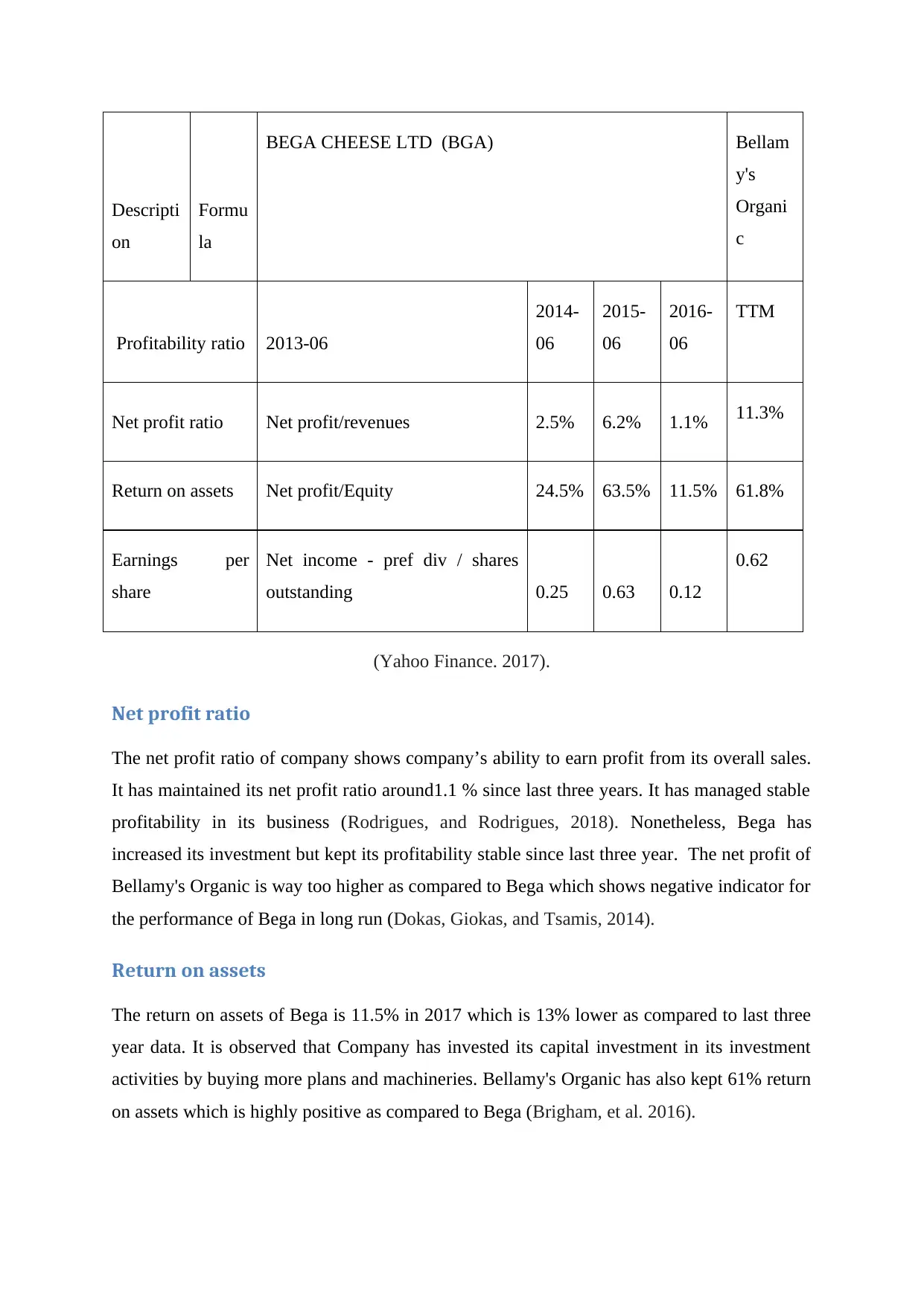
Descripti
on
Formu
la
BEGA CHEESE LTD (BGA) Bellam
y's
Organi
c
Profitability ratio 2013-06
2014-
06
2015-
06
2016-
06
TTM
Net profit ratio Net profit/revenues 2.5% 6.2% 1.1% 11.3%
Return on assets Net profit/Equity 24.5% 63.5% 11.5% 61.8%
Earnings per
share
Net income - pref div / shares
outstanding 0.25 0.63 0.12
0.62
(Yahoo Finance. 2017).
Net profit ratio
The net profit ratio of company shows company’s ability to earn profit from its overall sales.
It has maintained its net profit ratio around1.1 % since last three years. It has managed stable
profitability in its business (Rodrigues, and Rodrigues, 2018). Nonetheless, Bega has
increased its investment but kept its profitability stable since last three year. The net profit of
Bellamy's Organic is way too higher as compared to Bega which shows negative indicator for
the performance of Bega in long run (Dokas, Giokas, and Tsamis, 2014).
Return on assets
The return on assets of Bega is 11.5% in 2017 which is 13% lower as compared to last three
year data. It is observed that Company has invested its capital investment in its investment
activities by buying more plans and machineries. Bellamy's Organic has also kept 61% return
on assets which is highly positive as compared to Bega (Brigham, et al. 2016).
on
Formu
la
BEGA CHEESE LTD (BGA) Bellam
y's
Organi
c
Profitability ratio 2013-06
2014-
06
2015-
06
2016-
06
TTM
Net profit ratio Net profit/revenues 2.5% 6.2% 1.1% 11.3%
Return on assets Net profit/Equity 24.5% 63.5% 11.5% 61.8%
Earnings per
share
Net income - pref div / shares
outstanding 0.25 0.63 0.12
0.62
(Yahoo Finance. 2017).
Net profit ratio
The net profit ratio of company shows company’s ability to earn profit from its overall sales.
It has maintained its net profit ratio around1.1 % since last three years. It has managed stable
profitability in its business (Rodrigues, and Rodrigues, 2018). Nonetheless, Bega has
increased its investment but kept its profitability stable since last three year. The net profit of
Bellamy's Organic is way too higher as compared to Bega which shows negative indicator for
the performance of Bega in long run (Dokas, Giokas, and Tsamis, 2014).
Return on assets
The return on assets of Bega is 11.5% in 2017 which is 13% lower as compared to last three
year data. It is observed that Company has invested its capital investment in its investment
activities by buying more plans and machineries. Bellamy's Organic has also kept 61% return
on assets which is highly positive as compared to Bega (Brigham, et al. 2016).
Paraphrase This Document
Need a fresh take? Get an instant paraphrase of this document with our AI Paraphraser
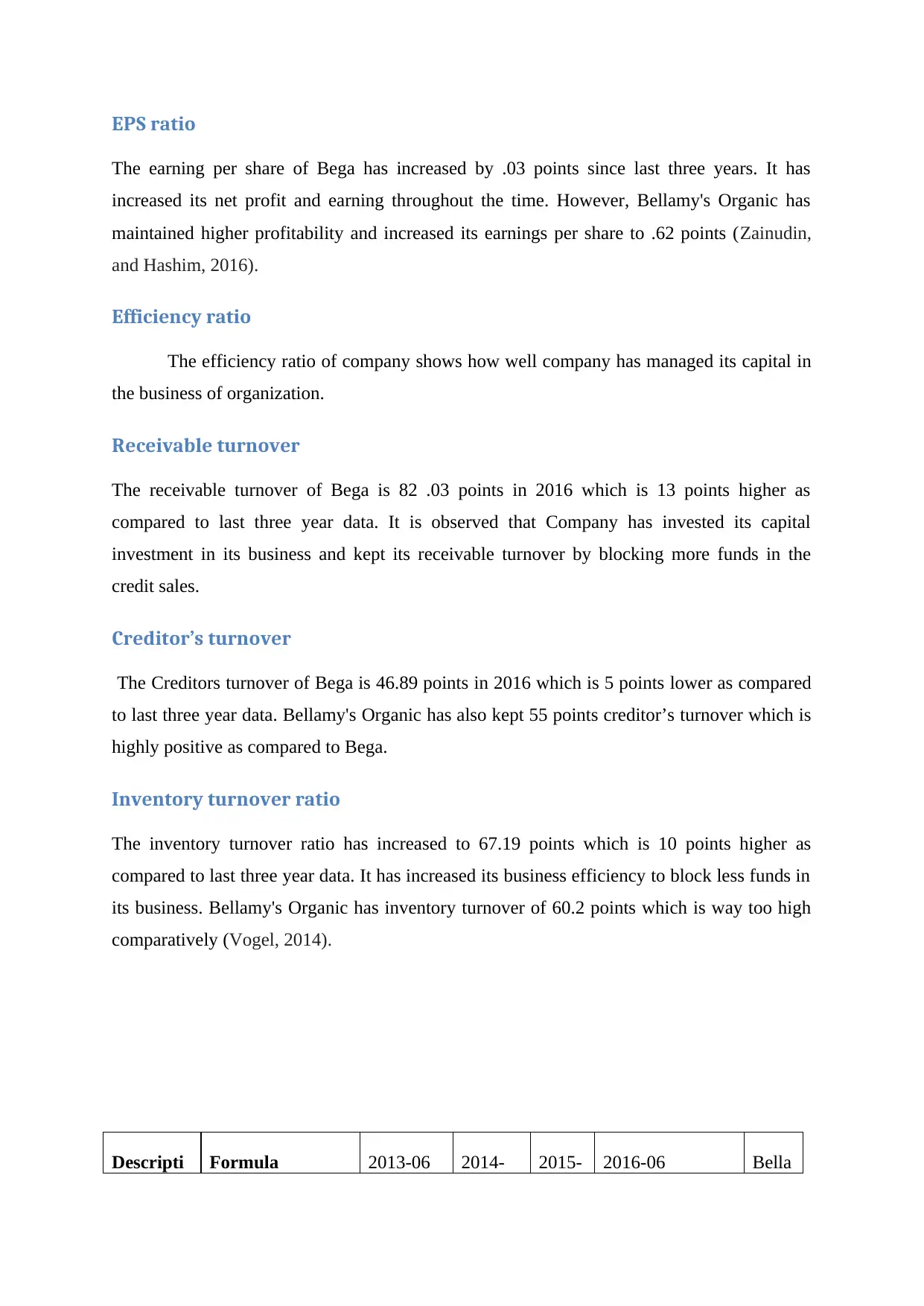
EPS ratio
The earning per share of Bega has increased by .03 points since last three years. It has
increased its net profit and earning throughout the time. However, Bellamy's Organic has
maintained higher profitability and increased its earnings per share to .62 points (Zainudin,
and Hashim, 2016).
Efficiency ratio
The efficiency ratio of company shows how well company has managed its capital in
the business of organization.
Receivable turnover
The receivable turnover of Bega is 82 .03 points in 2016 which is 13 points higher as
compared to last three year data. It is observed that Company has invested its capital
investment in its business and kept its receivable turnover by blocking more funds in the
credit sales.
Creditor’s turnover
The Creditors turnover of Bega is 46.89 points in 2016 which is 5 points lower as compared
to last three year data. Bellamy's Organic has also kept 55 points creditor’s turnover which is
highly positive as compared to Bega.
Inventory turnover ratio
The inventory turnover ratio has increased to 67.19 points which is 10 points higher as
compared to last three year data. It has increased its business efficiency to block less funds in
its business. Bellamy's Organic has inventory turnover of 60.2 points which is way too high
comparatively (Vogel, 2014).
Descripti Formula 2013-06 2014- 2015- 2016-06 Bella
The earning per share of Bega has increased by .03 points since last three years. It has
increased its net profit and earning throughout the time. However, Bellamy's Organic has
maintained higher profitability and increased its earnings per share to .62 points (Zainudin,
and Hashim, 2016).
Efficiency ratio
The efficiency ratio of company shows how well company has managed its capital in
the business of organization.
Receivable turnover
The receivable turnover of Bega is 82 .03 points in 2016 which is 13 points higher as
compared to last three year data. It is observed that Company has invested its capital
investment in its business and kept its receivable turnover by blocking more funds in the
credit sales.
Creditor’s turnover
The Creditors turnover of Bega is 46.89 points in 2016 which is 5 points lower as compared
to last three year data. Bellamy's Organic has also kept 55 points creditor’s turnover which is
highly positive as compared to Bega.
Inventory turnover ratio
The inventory turnover ratio has increased to 67.19 points which is 10 points higher as
compared to last three year data. It has increased its business efficiency to block less funds in
its business. Bellamy's Organic has inventory turnover of 60.2 points which is way too high
comparatively (Vogel, 2014).
Descripti Formula 2013-06 2014- 2015- 2016-06 Bella
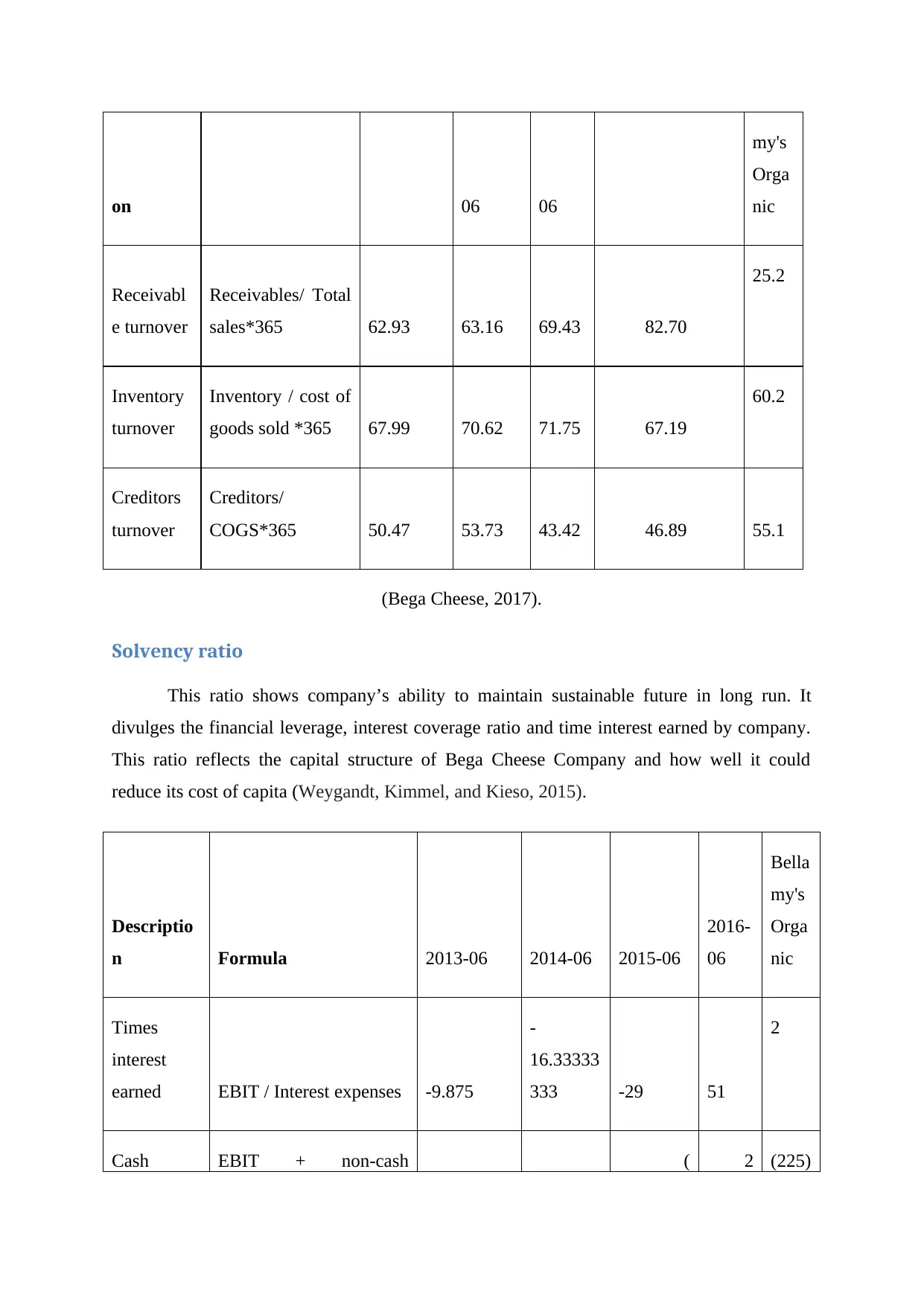
on 06 06
my's
Orga
nic
Receivabl
e turnover
Receivables/ Total
sales*365 62.93 63.16 69.43 82.70
25.2
Inventory
turnover
Inventory / cost of
goods sold *365 67.99 70.62 71.75 67.19
60.2
Creditors
turnover
Creditors/
COGS*365 50.47 53.73 43.42 46.89 55.1
(Bega Cheese, 2017).
Solvency ratio
This ratio shows company’s ability to maintain sustainable future in long run. It
divulges the financial leverage, interest coverage ratio and time interest earned by company.
This ratio reflects the capital structure of Bega Cheese Company and how well it could
reduce its cost of capita (Weygandt, Kimmel, and Kieso, 2015).
Descriptio
n Formula 2013-06 2014-06 2015-06
2016-
06
Bella
my's
Orga
nic
Times
interest
earned EBIT / Interest expenses -9.875
-
16.33333
333 -29 51
2
Cash EBIT + non-cash ( 2 (225)
my's
Orga
nic
Receivabl
e turnover
Receivables/ Total
sales*365 62.93 63.16 69.43 82.70
25.2
Inventory
turnover
Inventory / cost of
goods sold *365 67.99 70.62 71.75 67.19
60.2
Creditors
turnover
Creditors/
COGS*365 50.47 53.73 43.42 46.89 55.1
(Bega Cheese, 2017).
Solvency ratio
This ratio shows company’s ability to maintain sustainable future in long run. It
divulges the financial leverage, interest coverage ratio and time interest earned by company.
This ratio reflects the capital structure of Bega Cheese Company and how well it could
reduce its cost of capita (Weygandt, Kimmel, and Kieso, 2015).
Descriptio
n Formula 2013-06 2014-06 2015-06
2016-
06
Bella
my's
Orga
nic
Times
interest
earned EBIT / Interest expenses -9.875
-
16.33333
333 -29 51
2
Cash EBIT + non-cash ( 2 (225)
⊘ This is a preview!⊘
Do you want full access?
Subscribe today to unlock all pages.

Trusted by 1+ million students worldwide
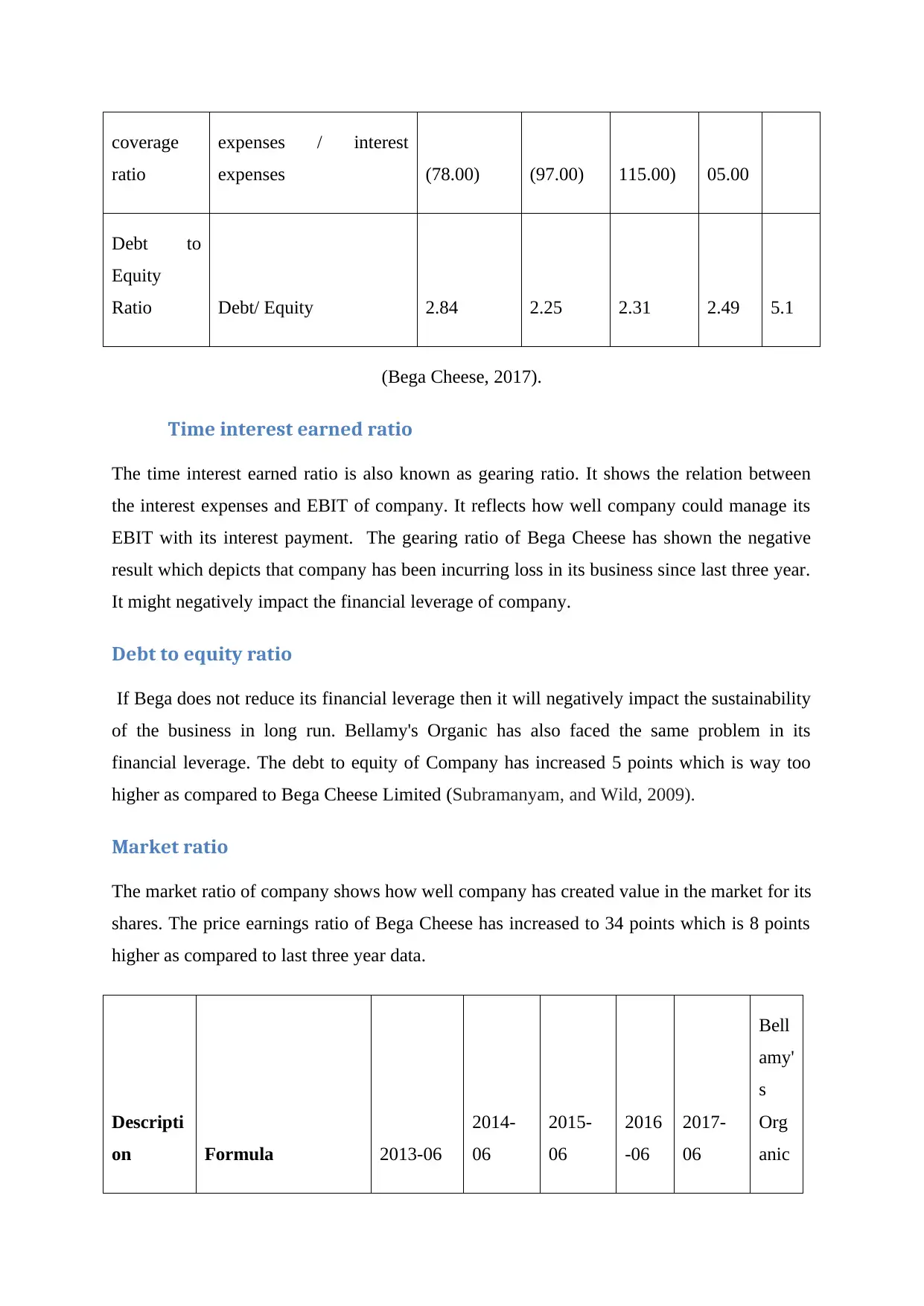
coverage
ratio
expenses / interest
expenses (78.00) (97.00) 115.00) 05.00
Debt to
Equity
Ratio Debt/ Equity 2.84 2.25 2.31 2.49 5.1
(Bega Cheese, 2017).
Time interest earned ratio
The time interest earned ratio is also known as gearing ratio. It shows the relation between
the interest expenses and EBIT of company. It reflects how well company could manage its
EBIT with its interest payment. The gearing ratio of Bega Cheese has shown the negative
result which depicts that company has been incurring loss in its business since last three year.
It might negatively impact the financial leverage of company.
Debt to equity ratio
If Bega does not reduce its financial leverage then it will negatively impact the sustainability
of the business in long run. Bellamy's Organic has also faced the same problem in its
financial leverage. The debt to equity of Company has increased 5 points which is way too
higher as compared to Bega Cheese Limited (Subramanyam, and Wild, 2009).
Market ratio
The market ratio of company shows how well company has created value in the market for its
shares. The price earnings ratio of Bega Cheese has increased to 34 points which is 8 points
higher as compared to last three year data.
Descripti
on Formula 2013-06
2014-
06
2015-
06
2016
-06
2017-
06
Bell
amy'
s
Org
anic
ratio
expenses / interest
expenses (78.00) (97.00) 115.00) 05.00
Debt to
Equity
Ratio Debt/ Equity 2.84 2.25 2.31 2.49 5.1
(Bega Cheese, 2017).
Time interest earned ratio
The time interest earned ratio is also known as gearing ratio. It shows the relation between
the interest expenses and EBIT of company. It reflects how well company could manage its
EBIT with its interest payment. The gearing ratio of Bega Cheese has shown the negative
result which depicts that company has been incurring loss in its business since last three year.
It might negatively impact the financial leverage of company.
Debt to equity ratio
If Bega does not reduce its financial leverage then it will negatively impact the sustainability
of the business in long run. Bellamy's Organic has also faced the same problem in its
financial leverage. The debt to equity of Company has increased 5 points which is way too
higher as compared to Bega Cheese Limited (Subramanyam, and Wild, 2009).
Market ratio
The market ratio of company shows how well company has created value in the market for its
shares. The price earnings ratio of Bega Cheese has increased to 34 points which is 8 points
higher as compared to last three year data.
Descripti
on Formula 2013-06
2014-
06
2015-
06
2016
-06
2017-
06
Bell
amy'
s
Org
anic
Paraphrase This Document
Need a fresh take? Get an instant paraphrase of this document with our AI Paraphraser
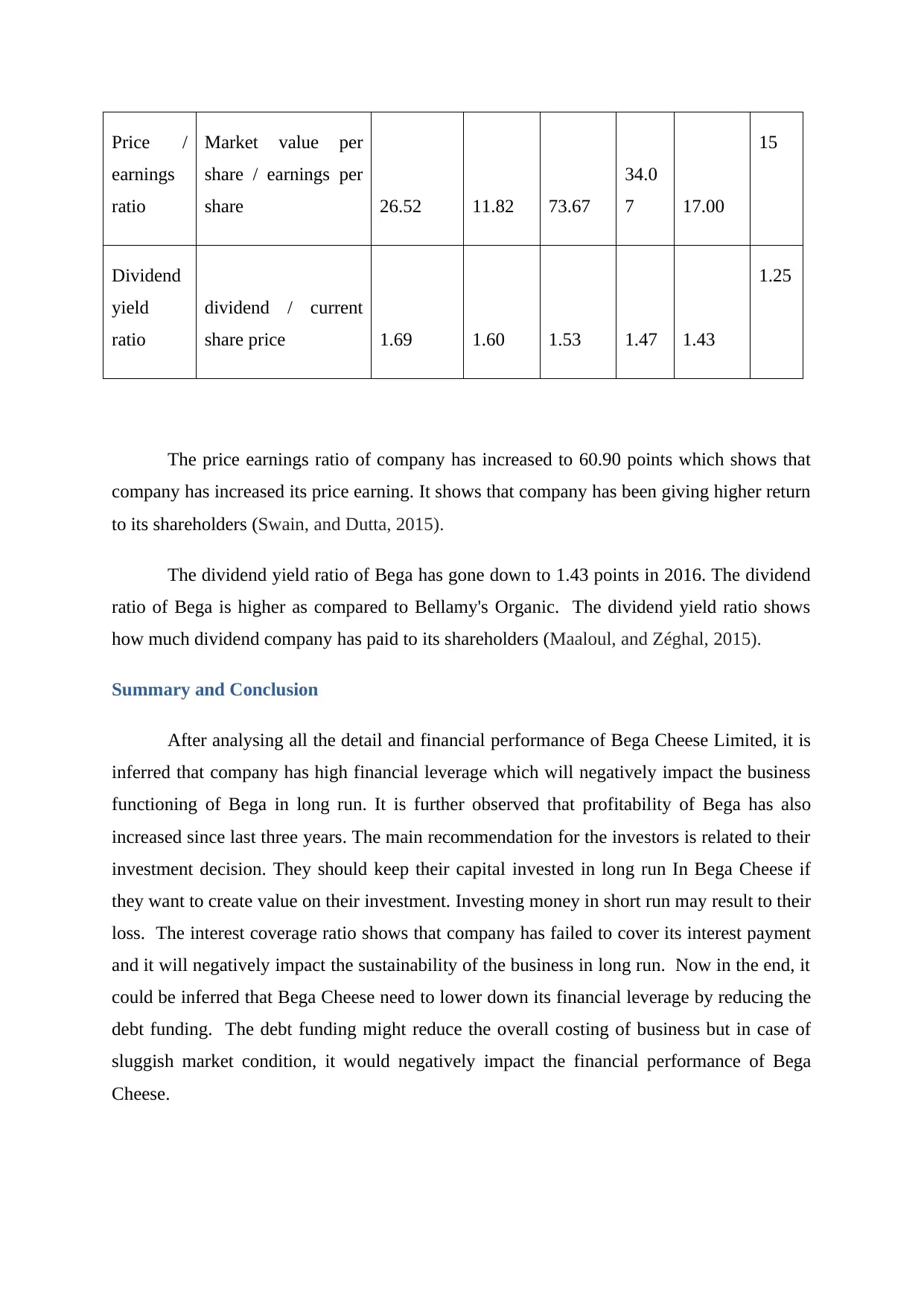
Price /
earnings
ratio
Market value per
share / earnings per
share 26.52 11.82 73.67
34.0
7 17.00
15
Dividend
yield
ratio
dividend / current
share price 1.69 1.60 1.53 1.47 1.43
1.25
The price earnings ratio of company has increased to 60.90 points which shows that
company has increased its price earning. It shows that company has been giving higher return
to its shareholders (Swain, and Dutta, 2015).
The dividend yield ratio of Bega has gone down to 1.43 points in 2016. The dividend
ratio of Bega is higher as compared to Bellamy's Organic. The dividend yield ratio shows
how much dividend company has paid to its shareholders (Maaloul, and Zéghal, 2015).
Summary and Conclusion
After analysing all the detail and financial performance of Bega Cheese Limited, it is
inferred that company has high financial leverage which will negatively impact the business
functioning of Bega in long run. It is further observed that profitability of Bega has also
increased since last three years. The main recommendation for the investors is related to their
investment decision. They should keep their capital invested in long run In Bega Cheese if
they want to create value on their investment. Investing money in short run may result to their
loss. The interest coverage ratio shows that company has failed to cover its interest payment
and it will negatively impact the sustainability of the business in long run. Now in the end, it
could be inferred that Bega Cheese need to lower down its financial leverage by reducing the
debt funding. The debt funding might reduce the overall costing of business but in case of
sluggish market condition, it would negatively impact the financial performance of Bega
Cheese.
earnings
ratio
Market value per
share / earnings per
share 26.52 11.82 73.67
34.0
7 17.00
15
Dividend
yield
ratio
dividend / current
share price 1.69 1.60 1.53 1.47 1.43
1.25
The price earnings ratio of company has increased to 60.90 points which shows that
company has increased its price earning. It shows that company has been giving higher return
to its shareholders (Swain, and Dutta, 2015).
The dividend yield ratio of Bega has gone down to 1.43 points in 2016. The dividend
ratio of Bega is higher as compared to Bellamy's Organic. The dividend yield ratio shows
how much dividend company has paid to its shareholders (Maaloul, and Zéghal, 2015).
Summary and Conclusion
After analysing all the detail and financial performance of Bega Cheese Limited, it is
inferred that company has high financial leverage which will negatively impact the business
functioning of Bega in long run. It is further observed that profitability of Bega has also
increased since last three years. The main recommendation for the investors is related to their
investment decision. They should keep their capital invested in long run In Bega Cheese if
they want to create value on their investment. Investing money in short run may result to their
loss. The interest coverage ratio shows that company has failed to cover its interest payment
and it will negatively impact the sustainability of the business in long run. Now in the end, it
could be inferred that Bega Cheese need to lower down its financial leverage by reducing the
debt funding. The debt funding might reduce the overall costing of business but in case of
sluggish market condition, it would negatively impact the financial performance of Bega
Cheese.
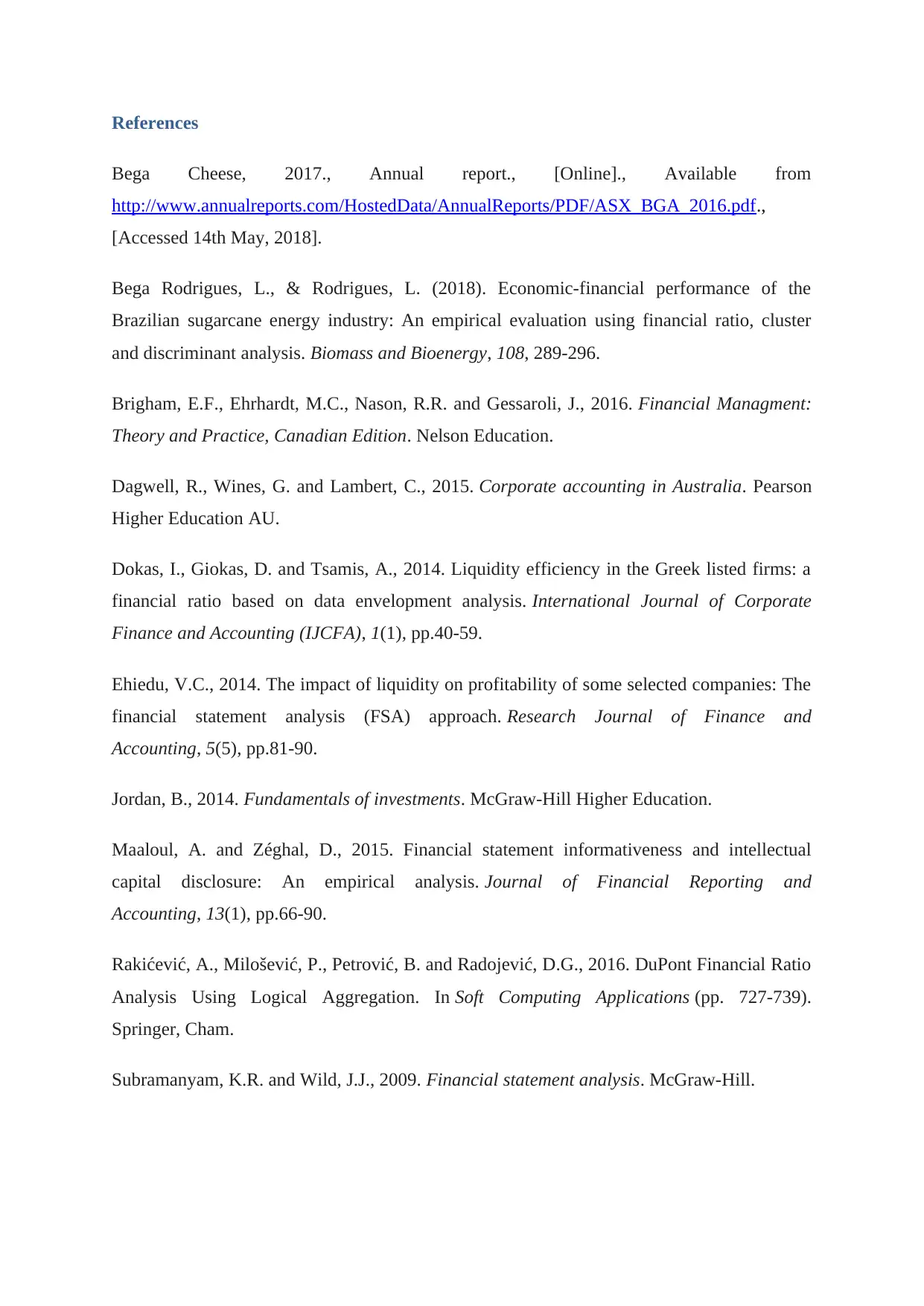
References
Bega Cheese, 2017., Annual report., [Online]., Available from
http://www.annualreports.com/HostedData/AnnualReports/PDF/ASX_BGA_2016.pdf.,
[Accessed 14th May, 2018].
Bega Rodrigues, L., & Rodrigues, L. (2018). Economic-financial performance of the
Brazilian sugarcane energy industry: An empirical evaluation using financial ratio, cluster
and discriminant analysis. Biomass and Bioenergy, 108, 289-296.
Brigham, E.F., Ehrhardt, M.C., Nason, R.R. and Gessaroli, J., 2016. Financial Managment:
Theory and Practice, Canadian Edition. Nelson Education.
Dagwell, R., Wines, G. and Lambert, C., 2015. Corporate accounting in Australia. Pearson
Higher Education AU.
Dokas, I., Giokas, D. and Tsamis, A., 2014. Liquidity efficiency in the Greek listed firms: a
financial ratio based on data envelopment analysis. International Journal of Corporate
Finance and Accounting (IJCFA), 1(1), pp.40-59.
Ehiedu, V.C., 2014. The impact of liquidity on profitability of some selected companies: The
financial statement analysis (FSA) approach. Research Journal of Finance and
Accounting, 5(5), pp.81-90.
Jordan, B., 2014. Fundamentals of investments. McGraw-Hill Higher Education.
Maaloul, A. and Zéghal, D., 2015. Financial statement informativeness and intellectual
capital disclosure: An empirical analysis. Journal of Financial Reporting and
Accounting, 13(1), pp.66-90.
Rakićević, A., Milošević, P., Petrović, B. and Radojević, D.G., 2016. DuPont Financial Ratio
Analysis Using Logical Aggregation. In Soft Computing Applications (pp. 727-739).
Springer, Cham.
Subramanyam, K.R. and Wild, J.J., 2009. Financial statement analysis. McGraw-Hill.
Bega Cheese, 2017., Annual report., [Online]., Available from
http://www.annualreports.com/HostedData/AnnualReports/PDF/ASX_BGA_2016.pdf.,
[Accessed 14th May, 2018].
Bega Rodrigues, L., & Rodrigues, L. (2018). Economic-financial performance of the
Brazilian sugarcane energy industry: An empirical evaluation using financial ratio, cluster
and discriminant analysis. Biomass and Bioenergy, 108, 289-296.
Brigham, E.F., Ehrhardt, M.C., Nason, R.R. and Gessaroli, J., 2016. Financial Managment:
Theory and Practice, Canadian Edition. Nelson Education.
Dagwell, R., Wines, G. and Lambert, C., 2015. Corporate accounting in Australia. Pearson
Higher Education AU.
Dokas, I., Giokas, D. and Tsamis, A., 2014. Liquidity efficiency in the Greek listed firms: a
financial ratio based on data envelopment analysis. International Journal of Corporate
Finance and Accounting (IJCFA), 1(1), pp.40-59.
Ehiedu, V.C., 2014. The impact of liquidity on profitability of some selected companies: The
financial statement analysis (FSA) approach. Research Journal of Finance and
Accounting, 5(5), pp.81-90.
Jordan, B., 2014. Fundamentals of investments. McGraw-Hill Higher Education.
Maaloul, A. and Zéghal, D., 2015. Financial statement informativeness and intellectual
capital disclosure: An empirical analysis. Journal of Financial Reporting and
Accounting, 13(1), pp.66-90.
Rakićević, A., Milošević, P., Petrović, B. and Radojević, D.G., 2016. DuPont Financial Ratio
Analysis Using Logical Aggregation. In Soft Computing Applications (pp. 727-739).
Springer, Cham.
Subramanyam, K.R. and Wild, J.J., 2009. Financial statement analysis. McGraw-Hill.
⊘ This is a preview!⊘
Do you want full access?
Subscribe today to unlock all pages.

Trusted by 1+ million students worldwide
1 out of 16
Related Documents
Your All-in-One AI-Powered Toolkit for Academic Success.
+13062052269
info@desklib.com
Available 24*7 on WhatsApp / Email
![[object Object]](/_next/static/media/star-bottom.7253800d.svg)
Unlock your academic potential
Copyright © 2020–2026 A2Z Services. All Rights Reserved. Developed and managed by ZUCOL.




